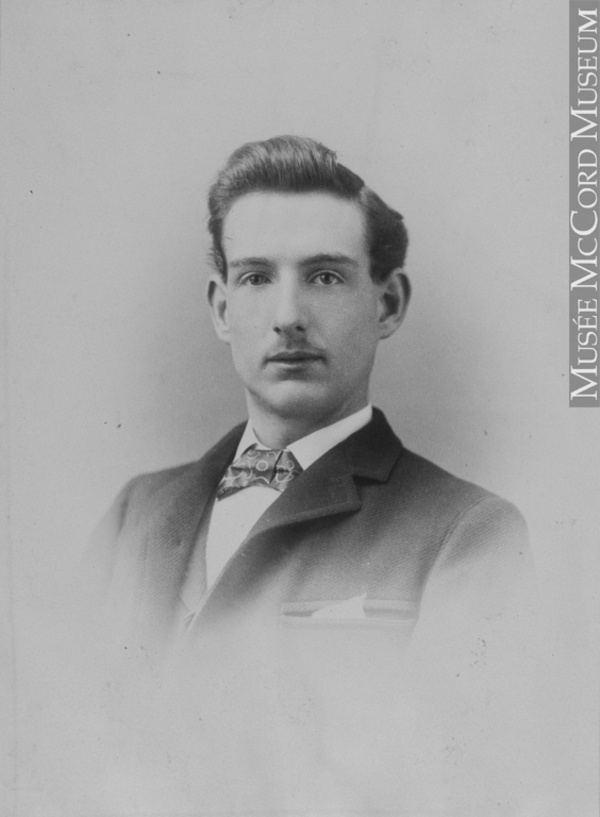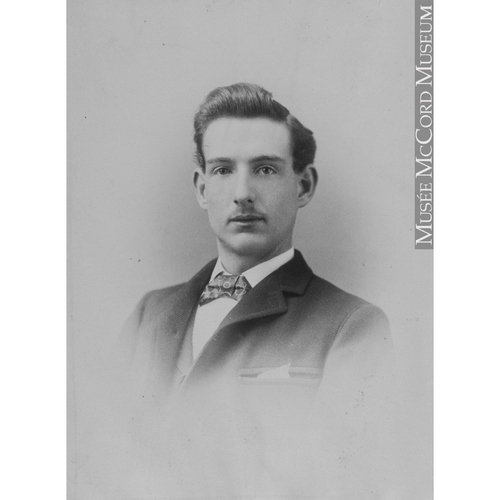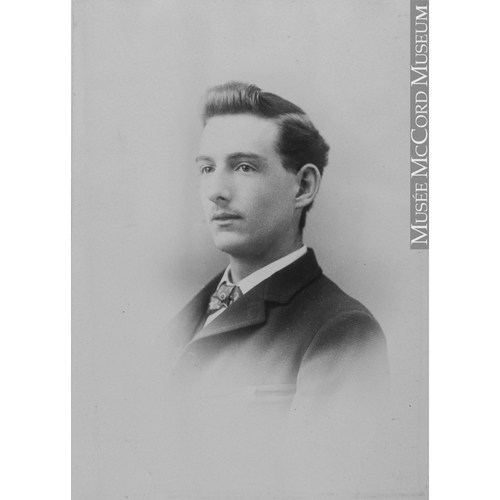
Source: Link
HERDT, LOUIS-ANTHYME, engineer, professor, and scientific consultant; b. 14 June 1872 in Trouville-sur-Mer, France, son of John Herdt, a banker, and Hélène-Denise-Amélie Fleury de La Hussinière; m. 4 May 1897 Blanche Dugas (d. 1907), daughter of judge Calixte-Aimé Dugas, in Montreal, and they had two sons; d. there 11 April 1926.
Louis-Anthyme Herdt’s family came to Montreal around 1880. As a Protestant, Louis-Anthyme at once began attending the prestigious High School of Montreal. In 1889 he entered McGill University, from which he graduated with a bachelor’s degree in electrical engineering in 1893. When he was called up for military service in France, he took the opportunity to obtain further training as an engineer in Europe. As it turned out, he was excused from military service because he was partially deaf and he enrolled in the Montefiore Institute of Electrotechnics in Liège, Belgium. A year later he continued his studies at the École Supérieure d’Électricité in Paris. On returning to Montreal in 1895, Herdt was hired as a demonstrator in the department of electrical engineering at McGill. He became a lecturer in 1897 and the following year obtained his master’s degree there. Teaching and research in the sciences at McGill were expanding significantly at the turn of the century. Thanks to the munificence of tobacco magnate Sir William Christopher Macdonald*, a number of buildings and laboratories specifically for the sciences, and especially the applied sciences, were erected on the university campus. In 1896, for instance, Macdonald gave $30,000 for the electrical engineering laboratory. It was under these exceptional circumstances that Herdt engaged in research, at a time when Quebec was on the verge of discovering its hydroelectric potential.
Herdt’s first experiments in the new laboratory were focused on the performance of electrical motors and alternators. He was working at the time with Robert Bowie Owens, the professor principally developing electrical engineering at McGill. With Owens’s assistance, Herdt perfected an invention that made it possible to guide ships through a canal. The ships had to be equipped at the bow with a device for detecting changes in a magnetic field generated by an underwater cable. The captain could then keep the ship on the course set by the cable, even in conditions of zero visibility. This invention, which was tested for the first time in 1904 on the St Lawrence in the presence of Raymond Préfontaine*, the minister of marine and fisheries, earned high praise for Herdt from the scientific community. It was not until World War I, however, that its full potential was revealed. Thanks to Herdt’s invention, ships of the Royal Navy could be guided into English ports during the war. In 1907 Herdt became an assistant professor at McGill. Two years later he held the Macdonald chair of electrical engineering and succeeded Owens as head of the department, a position he retained for the rest of his life. The university recognized the importance of his scientific work by granting him a dsc in 1910.
At the end of the 19th century, wide-ranging economic changes forced provincial governments and municipalities to create new agencies to regulate the exploitation of natural resources and to coordinate the establishment of the main public utilities. Scientific consultants, of whom engineers certainly were the largest group, had to be recruited for commissions of inquiry, technical services, government departments, and supervisory commissions. Herdt’s interest in solving concrete problems in the field of electricity placed him in the front rank of the experts on whom these bodies called for assistance. In 1907 he was appointed to the Board of Consulting Engineers of the City of Winnipeg, which supervised work on the Pointe du Bois hydroelectric station. Whether it was to develop the hydroelectric potential of the Ottawa River or of New Brunswick, Herdt was approached for his opinion in order to inform decision-makers. He was a member of most of the public utility commissions in Montreal. In 1912 he was appointed by provincial order in council chair of the Electrical Commission of the City of Montreal, whose responsibilities included supervising the construction of underground conduits for the city’s many electric cables. When the Quebec government created the Montreal Tramways Commission in 1916 to ensure some uniformity in the services and contracts of the Montreal Tramways Company, Herdt acted as consulting engineer. A 36-year agreement between the city and this corporation was signed in June 1918. The Montreal Tramways Commission then became a permanent agency and Herdt was appointed one of its two vice-presidents. Decisions on public transportation in Montreal would now come under the jurisdiction of this body, rather than that of a private company or of the city. In the same year Herdt went to the United States to study various metropolitan transportation systems.
Because of his involvement in public utilities and his scientific accomplishments, Herdt came to hold prestigious offices in national and international organizations. He was elected a member of the Canadian Society of Civil Engineers in 1899 and served as a member of its council from 1907. As a delegate to the International Electro-Technical Commission held in London, England, in June 1906, he helped define standards in the field of electricity. He was admitted to membership in the Royal Society of Canada in 1911.
When World War I broke out, Herdt went to France to take part in the war effort, but the French military authorities asked him to return to Canada, where his services would be more useful. Soon afterwards he became technical consultant to the French Artillery Mission in New York, overseeing the contracts it signed and the material it purchased from Canadian manufacturers for field telephones. The French government would award him the Legion of Honour in 1923 in recognition of his services.
In the mid 1920s, Louis-Anthyme Herdt began to experience health problems. He suffered from depression and was treated at the Royal Victoria Hospital. On Sunday, 11 April 1926, his son John Dougas noticed that his father, when leaving the house for his office at McGill University, as he did every Sunday, seemed back in form. A couple of hours later Herdt’s body was found by one of the watchmen of the building. At the age of only 53, the renowned McGill professor and vice-chairman of the Montreal Tramways Commission had shot himself in the head, putting a tragic end to a brilliant scientific career. Over the years he had helped develop standards in a number of fields connected with the use of electricity. He had also distinguished himself as a technical consultant in the setting up of hydroelectric stations and had proved an important expert for public agencies charged with the regulation of recognized utilities.
Louis-Anthyme Herdt is the author of: Notes of polyphase equipments of some European high speed electric railways ([Montreal?, 1902?]); The use of electricity on the Lachine Canal ([Montreal?, 1904?]); and Electrolysis in the city of Winnipeg (n.p., [1910?]). He also published several articles, notably in Canadian Electrical News and Engineering Journal (Toronto) and in Canadian Soc. of Civil Engineers, Trans. (Montreal). A partial list of his publications can be found in Science and technology biblio. (Richardson and MacDonald).
ANQ-M, CE601-S1, 4 mai 1897. Arch. Départementales, Calvados (Caen, France), État civil, Trouville-sur-Mer, 17 juin 1872. MUA, Reference Room Staff Index, Herdt, L.-A.; RG 49, scrapbooks and newspaper clippings, 1–6. Montreal Daily Star, 13 April 1926. Christopher Armstrong and H. V. Nelles, Monopoly’s moment: the organization and regulation of Canadian utilities, 1830–1930 (Philadelphia, 1986), 251–54. Canadian men and women of the time (Morgan; 1912). “Dr. Louis A. Herdt,” McGill News (Montreal), 7, no.3 (June 1926): 29–30. R. C. Fetherstonhaugh, McGill University at war, 1914–1918, 1939–1945 (Montreal, 1947). S. B. Frost, McGill University: for the advancement of learning (2v., Montreal, 1980–84), 2: 104. Robert Gagnon et A. J. Ross, Histoire de l’École polytechnique, 1873–1990; la montée des ingénieurs francophones (Montréal, 1991), 178–81. Linteau, Hist. de Montréal, 273. “Louis Anthyme Herdt,” RSC, Trans., 3rd ser., 20 (1926), proc.: xxi–xxiv. McGill Univ., Annual report (Montreal), 1894–1926.
Cite This Article
Robert Gagnon, “HERDT, LOUIS-ANTHYME,” in Dictionary of Canadian Biography, vol. 15, University of Toronto/Université Laval, 2003–, accessed January 18, 2026, https://www.biographi.ca/en/bio/herdt_louis_anthyme_15E.html.
The citation above shows the format for footnotes and endnotes according to the Chicago manual of style (16th edition). Information to be used in other citation formats:
| Permalink: | https://www.biographi.ca/en/bio/herdt_louis_anthyme_15E.html |
| Author of Article: | Robert Gagnon |
| Title of Article: | HERDT, LOUIS-ANTHYME |
| Publication Name: | Dictionary of Canadian Biography, vol. 15 |
| Publisher: | University of Toronto/Université Laval |
| Year of publication: | 2005 |
| Year of revision: | 2005 |
| Access Date: | January 18, 2026 |




